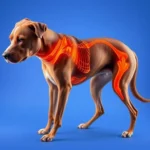
Introduction
Dental health is a crucial aspect of your dog’s overall well-being. Just like in humans, maintaining a healthy mouth can prevent a range of medical issues, including heart disease and kidney problems. Dogs’ teeth can become discolored for various reasons, which not only affects their appearance but can also indicate underlying health issues that may need attention.
When you notice that your dog’s tooth is discolored, it’s important to consult a veterinarian. They play a vital role in diagnosing dental problems and advising on the appropriate course of action. This article aims to educate pet owners on the causes and implications of tooth discoloration in dogs, as well as possible treatments and preventive measures.
Understanding Dog Dental Health
Importance of Dental Hygiene for Dogs
Maintaining good dental hygiene for dogs is essential for their health. Poor dental care can lead to periodontal disease, which can cause pain, tooth loss, and infection. Common dental diseases in dogs include gingivitis, periodontitis, and tooth decay. These conditions can significantly affect a dog’s quality of life and may lead to more serious health issues if left untreated.
Anatomy of a Dog’s Tooth
To understand why a dog’s tooth is discolored, it’s important to know the tooth’s anatomy. A dog’s tooth consists of several parts:
- Enamel: The hard outer layer that protects the tooth.
- Dentin: The layer beneath the enamel that supports the structure.
- Pulp: The innermost part containing nerves and blood vessels.
Discoloration can occur in any of these layers, often indicating a problem that needs veterinary attention.
Causes of Discoloration in Dogs’ Teeth
Possible Medical Conditions
Periodontal Disease
Periodontal disease is a common dental issue in dogs that can lead to tooth discoloration. The buildup of plaque and tartar can cause inflammation of the gums, leading to a yellow or brown appearance in the affected teeth. If untreated, it can progress to more severe dental issues, including tooth loss.
Tooth Decay
Tooth decay, although less common in dogs than in humans, can occur. Cavities form when bacteria produce acids that erode the enamel. A decayed tooth may show dark spots or holes, indicating the need for immediate veterinary care.
Infection
Dental infections can cause significant changes in a dog’s tooth color. An abscessed tooth may appear discolored due to pus accumulation and inflammation. This condition is often accompanied by severe pain and requires prompt treatment.
External Factors
Diet and Nutrition
Certain foods and treats can stain your dog’s teeth. For example, highly pigmented foods, like beets or some dog treats, can lead to discoloration. Additionally, a high-sugar diet can increase the risk of dental issues, including cavities.
Trauma or Injury
Injuries to a dog’s mouth can also lead to discoloration. A fall or a knock can damage a tooth’s structure, resulting in changes in color or even fractures. It’s essential to monitor your dog for any signs of trauma.
Age-Related Changes
As dogs age, their teeth may naturally become discolored. The enamel can wear down, making the underlying dentin more visible. Additionally, older dogs may develop various dental issues that can contribute to discoloration.
Identifying Tooth Discoloration in Dogs
Types of Discoloration
Yellowing
Yellowing teeth can indicate tartar buildup or periodontal disease. If your dog’s teeth are turning yellow, it may be time for a dental cleaning.
Brown Stains
Brown stains are often a sign of severe plaque buildup or decay. They can indicate that your dog is at risk for periodontal disease and should be evaluated by a veterinarian.
Black Spots
Black spots on a dog’s teeth are serious and can suggest decay or infection. These spots can indicate that the tooth has reached a critical level of deterioration, requiring immediate veterinary assessment.
Signs and Symptoms to Look For
When monitoring your dog’s dental health, keep an eye out for:
- Bad breath (halitosis): A common sign of dental issues.
- Swelling or redness in gums: Indicates gum disease or infection.
- Changes in eating or chewing habits: Reluctance to eat or chew may suggest dental pain.
When to Consult a Veterinarian
Recognizing Urgency
There are several red flags that indicate your dog needs immediate veterinary attention. If you notice severe discoloration accompanied by swelling, bleeding gums, or signs of pain, it’s crucial to consult a veterinarian. Additionally, regular dental check-ups are essential to catch potential issues before they escalate.
The Veterinary Examination Process
During a veterinary examination, the vet will perform a thorough oral examination. They may use tools to examine the gums and teeth closely. Diagnostic tests, such as X-rays, may be necessary to assess the tooth’s health beneath the surface. Depending on the findings, a dental cleaning may be recommended.
Treatment Options for Discolored Teeth
Home Care and Preventive Measures
Brushing Teeth
Regular brushing is vital for maintaining your dog’s dental health. Using a dog-specific toothbrush and toothpaste can help remove plaque and prevent tartar buildup. Aim to brush your dog’s teeth at least two to three times a week for optimal results.
Dental Treats and Chews
Consider incorporating dental treats and chews into your dog’s routine. Many products are designed specifically to help reduce plaque and promote healthy teeth. Look for those approved by veterinary dental associations for the best results.
Professional Treatment Options
Dental Cleaning
Professional dental cleaning involves a thorough examination and cleaning of your dog’s teeth, usually under anesthesia. This process removes tartar and plaque buildup, helping to restore your dog’s dental health.
Tooth Extraction
In cases where a tooth is severely decayed or infected, extraction may be necessary. This procedure alleviates pain and prevents further complications. Your veterinarian will discuss options with you and explain the best course of action.
Medications
If an infection is present, your veterinarian may prescribe medications to manage pain or treat infection. Antibiotics may be necessary to clear up any bacterial issues before proceeding with dental care.
Preventing Tooth Discoloration
Best Practices for Dog Dental Care
To help prevent tooth discoloration, maintain a consistent dental care routine. Regular brushing, dental chews, and routine veterinary check-ups are essential for keeping your dog’s teeth healthy.
Nutrition and Dental Health
A balanced diet plays a significant role in maintaining dental health. Consider feeding your dog a diet designed to promote oral health and avoid sugary treats that can contribute to decay. Consult your veterinarian for specific dietary recommendations that suit your dog’s needs.
Conclusion
Dental care is vital for your dog’s health, and discolored teeth can indicate underlying issues that need attention. Regular monitoring of your dog’s dental health, combined with preventive care, can significantly reduce the risk of complications. Be proactive in scheduling veterinary check-ups and addressing any concerns promptly. Observing changes in your dog’s dental health is essential, and don’t hesitate to seek help when you notice something amiss.
FAQs
Why is my dog’s tooth discolored?
Tooth discoloration can be caused by various factors, including dental disease, trauma, diet, or age-related changes.
What should I do if I notice brown stains on my dog’s teeth?
Brown stains often indicate severe plaque buildup or decay. Schedule a veterinary appointment for an examination and possible cleaning.
Is tooth discoloration in dogs common?
While it can be common, especially in older dogs, it should not be ignored. Always consult your veterinarian if you notice changes in your dog’s teeth.
How can I prevent my dog’s tooth from discoloring?
Regular brushing, dental treats, and a balanced diet can help maintain oral hygiene and prevent discoloration.
When should I start brushing my dog’s teeth?
It’s best to start brushing your dog’s teeth as early as possible, ideally when they are a puppy. However, it’s never too late to start caring for your dog’s dental health.
Taking proactive measures for your dog’s dental care can lead to a healthier, happier life for your furry friend. Don’t hesitate to reach out to your veterinarian with questions or concerns about your dog’s dental health.









